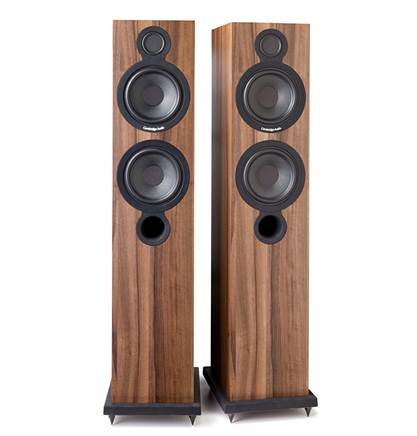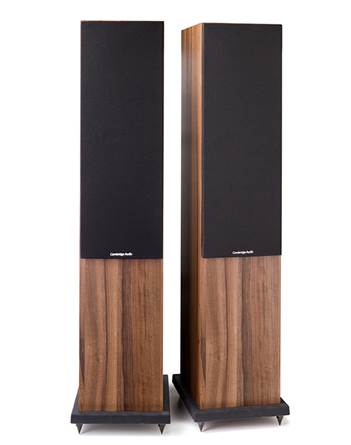Those twin bass units both feature paper cones. Having
experimented for years with cone materials, designer Dominic Baker is now a fan
of certain types of paper pulp in speaker cones; he says these have a great
combination of stiffness and lightness that other materials can’t match. A
single large reflex port lets the twin woofers breathe, firing forward into the
room. The MDF cabinet has a choice of black or dark walnut finishes, and you
won’t find bi-writable binding posts round the back because Dominic doesn’t
think they offer an acceptable cost/benefit.
Sound quality
Often, moving from a small stand mount to a big floor
stander creates more problems than it solves, but the Aero 6 emerges as the
better of the two speakers in my view.

Seamless
BMR treble/mid driver
Cleverly, you get all the benefits of having two woofers
pumping away shifting air, but none of the pitfalls of having a bigger cabinet
to keep in check. And fascinatingly, the benefits don’t simply manifest
themselves as better bass, you also get improvements right up the frequency
band. Treble seems a little more relaxed and tuneful, midband is easier, more
effortless and more dynamic and, of course, bass is far bigger booted.
Still, this is very much an Aero loudspeaker; both the 2 and
the 6 sound like nothing else around at the price, and that’s meant in a good
way. Their baseline is a wonderfully expansive sound, one that’s tonally
extremely even and devoid of peaks and troughs. At first listen, this can
manifest itself as being slightly over-smooth, but give it a few minutes and as
soon as you’ve realized it’s not going to shout at you, you find yourself listening
further into the music. The Aeros begin to sound very immersive, and the floor
standers seem to exacerbate this effect, pulling you further into the sound. Rhythmically,
because there’s no coruscating treble coming at you, or clanging midband, you
can on first appraisal mistake the smoothness and evenness for a slight lack of
bite. But you soon realize that these speakers are as fast as anything at or
near the price, it’s just that they’re not crashing their way through the
music.

Those
twin bass units marry up superbly and make it a delightful listen
You get into a zone, where you can enjoy their natural
musicality and effortless ease. It’s actually rather hard to
describe, because so few speakers do this – possibly Quad electrostatics and
Martin Logan hybrids at the top end of the market, but not many others. The
sound coming from the Aero 6s is simply different to almost all other speakers
on the market in one respect, thanks to that seamless BMR treble/mid driver and
the way it is used. Meanwhile, those twin bass units marry up superbly and make
it a delightful listen.
I found that the Aero 2s had a slight lack of
atmosphere right at the very top, but the 6s are less guilty of this. Treble
isn’t as incisive as Q Acoustics’ 2050i, for example, but it has a lovely
floaty quality that means hi-hats are carried with super timing.

165mm
bass drive unit, oudspeaker binding posts
On The The’s I’ve Been Waiting, it’s unusually
easy to hear the interaction between the bass, snares and cymbals and this
becomes a really key part of the song. Behind this Matt Johnson’s plaintive
vocals soar, giving the song an epic feel. At the same time, loads of detail is
thrust out stage left and right, from guitar licks to backing synths. The
effect is powerful, engrossing even, yet tonally it’s as smooth as silk – not
something you can say of most budget speakers.For a $1069 box, the Aero 6s can
shift large amounts of air.